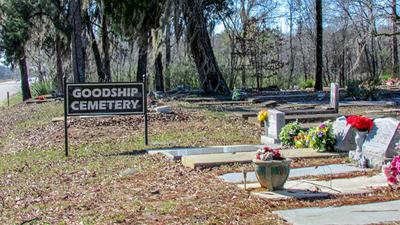Some of my best memories growing up at Elmore Station in west Elmore County during the late 1940s and early 1950s involved going to Montgomery with my granddaddy.
My granddaddy, Papa Gantt, my mother’s father, lived with us. He called himself a jackleg carpenter. I am not sure what a jackleg carpenter is, but it could be a person who sometimes builds things but also excels in porch-swing sitting. He did a lot of both.
Periodically, we would load up in his 1934 Chevrolet one seater and head south on state Route 45 – commonly called the Montgomery Highway – currently state Route 143. Never exceeding the speed of 30 mph, we would cross the Mortar Creek Bridge south of Elmore and putter on through Robinson Springs and Millbrook, crossing the Tyler-Goodwyn Bridge over the Alabama River just beyond the Elmore/Montgomery county line.
We would hold our noses as we passed the north Montgomery stockyards and then headed on into the city. The routine was always the same. We would park the car in a parking lot near Union Station and walk uptown to the Sears Roebuck Store where my Papa would purchase carpenter supplies or maybe some kind of tool.
On our trips down Highway 45 into Montgomery, there were many interesting sites along the way. There was the Elmore Airfield (now the Wetumpka Municipal Airport), Paige Hill that we always coasted down to save gasoline on our way home and the huge oak trees that lined the heart of Millbrook and provided a cool and refreshing respite on a hot summer day.
The one site that was the most mysterious was a cemetery just beyond the Cobbs Ford Road with a sign declaring it The Goodship Cemetery – an interesting name for a cemetery.
The graveyard was and still is a little spooky with its trees displaying weeping streams of Spanish moss, so familiar along the Alabama River basin. It was also a picturesque sacred landmark and the final resting place for members of the Goodship Missionary Baptist Church, located just across the highway.
Goodship is also an interesting name for a church, but its history is even more intriguing. The Goodship Missionary Baptist Church is the first (depending on who is asked) organized African American Church in historical Coosada, Robinson Springs and Millbrook in west Elmore County. The church’s own historical sketch reveals that it was established in 1875 with a gift of an acre of land from Tyler Goodwyn.
The Goodwyn family of Robinson Springs (sometimes spelled Goodwin) was connected by marriage to the Peyton Dandridge Bibb family that had huge land holdings in the area. Bibb’s daughter Harriett Bibb Goodwyn (1814-1873), for whom Bibb’s first riverboat was named – as well as The Harriett II, which is currently docked at the River Front Park in Montgomery – married Albert Gallatin Goodwyn (1807-1874) who relocated to Robinson Springs during the great migration, referred to as Alabama Fever.
According to family records, The Goodwyns had a son named Albert Taylor Goodwyn (1842-1931) who was born at Robinson Springs. He was a prominent statesman who served in the United States Congress and in both houses of the Alabama Legislature.
Albert Taylor married Priscilla Tyler Goodwyn (1849-1936), a descendant of John Tyler, the 10th President of the United States. They named their first child Robert Tyler (1870-1963) for whom the Tyler-Goodwyn Bridge over the Alabama River is named, just a short distance down the road from the Goodship Church.
Since Robert Tyler Goodwyn was not born until 1870, it’s reasonable to surmise that his father Albert Taylor Goodwyn gave the land and also suggested the name of Goodship for the church.
According to church members Mr. Willie Davis, senior deacon and Mrs. Willie Mae Duncan, former trustee, no one today seems to know the significance of the name. Upon investigation it appears the word goodship is obsolete. The word is no longer listed in Webster’s Dictionary but can be traced to the 16th century Middle English spelling of goodschipe meaning, favor, grace or kindness and from Old English godscipe meaning kindness. These words would certainly be appropriate for a church, so perhaps the mystery is solved.
The founders of the Goodship Church were no doubt proud of their good fortune of donated land but also determined in their mission to establish a worshiping community to do God’s work. Their beginnings were meager as they used to meet under a brush arbor (four poles with brush on top to keep out the sun and sometimes rain). Under the leadership of their first pastor, Rev. Horace Khorn, the first church building was erected in 1891, and an additional two acres of land was purchased to establish the cemetery.
The congregation prospered, and the church building was replaced with a new building in 1901 and another in 1916. Unfortunately, this building burned down but was rebuilt in 1932 during the financial great depression of that period. It is reported that the deacons even mortgaged their mules to buy materials for the building.
As the Goodship Church continued to prosper, this building experienced many improvements over the years, until 2004 when it tragically burned again. Not to be discouraged, the Goodship Church rose from its ashes and stands today in magnificent glory at its original location on state Route 143 across the street from its enchanting cemetery.
The church and its people have endured 142 years of prosperity and tragedy, but with each tragedy it has become bigger and better. Starting from a small worshiping group under a brush arbor in 1875 to its current membership of 400-plus is no small feat.
Bravo to this congregation for its tenacity and commitment to its mission. The Goodship Missionary Baptist Church, including the cemetery, is indeed a significant historical landmark in west Elmore County. Under the leadership of the church’s current Senior Pastor, Rev. Derwin V. Perry, its associate ministers, deacons and trustees, they are planning for the next 142 years.








